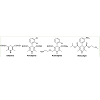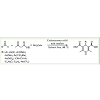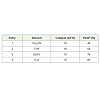Research Article
Efficient One Pot Synthesis of 1,4-Dihydropyridines Under Solvent Free Conditions Using Carbonaceous Solid Acid Catalyst
Raju S Thombal, Vrushali H Jadhav*
Corresponding author: Vrushali H Jadhav, Division of Organic Chemistry, National Chemical Laboratory (CSIR-NCL), Pune-411008, Tel: +91 (20) 25902275, India; E-mail: vh.jadhav@ncl.res.in
Citation: Thombal RS, Jadhav VH. Efficient One Pot Synthesis of 1,4-Dihydropyridines Under Solvent Free Conditions Using Carbonaceous Solid Acid Catalyst. J Chem Applied Biochem. 2015;2(1): 111.
Copyright © 2015 Jadhav VH et al. This is an open access article distributed under the Creative Commons Attribution License, which permits unrestricted use, distribution, and reproduction in any medium, provided the original work is properly cited.
Submission: 08/09/2015; Accepted: 14/09/2015; Published: 19/09/2015
Abstract
Carbonaceous solid acid catalyst was used for convenient and efficient synthesis of 1,4-dihydropyrine (DHP) derivatives under solvent free conditions. The main advantages of these protocol includes short reaction time, high yields, recyclable catalyst, selectivity towards 1,4-dihydropyridine derivatives, practical simplicity and work up free reaction conditions. Catalyst can be recovered and reused for five runs without any significant impact on yields of products.
Keywords: Carbonaceous; Dihydropyridine; Solvent free; Recovered; Reused
Introduction
1,4-Dihydropyridines (DHP’s) are an important class of bioactive molecules, well-known for their role as calcium channel modulators and used extensively for the treatment of hypertension. The derivatives of DHP have shown a variety of biological activities and pharmacological activities, such as anti-tubercular, anti-convulsant, anti-tumour, anti-analgesic, anti-inflammatory, cardiovascular disease and stress protective activities [1-4]. Extensive studies have revealed that these compounds exhibit various medicinal functions such as neuroprotectant, cerebral anti-ischemic activity in the treatment of Alzheimer’s disease, and chemosensitizer in tumour therapy [5].
These examples clearly indicate the remarkable potential of novel dihydropyridine derivatives as a source of valuable drug candidates. Several DHP’s which are commercial products such as Diludine, Felodipine, Amlodipine, Nimodipin etc. are manufactured and used worldwide (Figure 1) [6,7]. Synthesis of 1,4-dihydropyridine was for the first time developed by Arthur Hantzsch in 1882 [8]. Realizing the biological importance of DHP derivatives, several synthetic methods have been reported till date such as Lewis acid catalyst [9-12], ionic liquids [13-17], organocatalysis [18], microwave assisted [19-23], heteropolyacids [24], nanoparticles [25], solar thermal energy [26], ultrasound irradiation [27], visible light [28], solid support [29-31], salts [32,33] and Grignard reagents [34]. However, a number of methods have been reported for the synthesis of DHPs, which suffer from drawbacks like longer reaction times, low to moderate yields, and require highly acidic reaction conditions. It is noteworthy to observe that disposal of toxic solvents often pose environmental and health problems. Therefore, the search for a better catalyst for the synthesis of DHP derivatives using less hazardous solvents or solvent free conditions is of prime importance.
Materials and Methods
Chemicals
All reagents were purchased from Aldrich, Fluka, MERCK, TCI and were used without further purification. IR was measured on Bruker Alpha instrument. NMR spectra were recorded in CDCl3 at 25 °C on Bruker 500 (500 MHz). For 1H NMR spectra, proton chemical shifts (δ) are given in ppm relative to tetramethylsilane (0.00 ppm) in CDCl3. Multiplicities are indicated by s (singlet), d (doublet), t (triplet), m (multiplet), and br (broad). Confirmations of products were analyzed by GCMS.
General procedure for 1,4-dihydropyridine synthesis
A mixture of aldehyde (1 mmol), ethyl acetoacetate (2 mmol), ammonium acetate (1 mmol) and catalyst (10 wt %) were stirred in round bottle flask (10 mL) under solvent free conditions at 80 °C for required time. After completion of the reaction, EtOAc (25 mL) was added and the catalyst was removed by filtration. The filtrate was concentrated under reduced pressure, to afford crude DHP derivatives which were then column purified to obtain pure 1,4-DHP products.
Characterization
(Table 3, Entry 1): Yield-92%, m.p. 160-162 °C; Rf: 0.52 (Ethyl Acetate: Pet ether = 3:7); IR (CHCl3) υ = 3342, 2982, 1652, 1488, 703 cm-1; 1H NMR (CDCl3, 500 MHz) δ 1.21 (t, J = 7.2 Hz, 6H), 2.31 (s, 6H), 4.01-4.16 (m, 4H), 4.99 (s, 1H), 5.78 (s, 1H), 7.07-7.30 (m, 5H); MS (EI) m/z 329.
(Table 3, Entry 2): Yield-85%, mp 115-118 °C; Rf: 0.56 (Ethyl Acetate: Pet ether = 3:7); IR (CHCl3) υ = 3343, 2920, 2538, 2252, 1682, 1492, 732 cm-1; 1H NMR (CDC13, 500 MHz) δ 1.20 (t, J = 7.1Hz, 6H), 2.27 (s, 6H), 3.72 (s, 3H), 3.74 (s, 3H), 4.01-4.12 (m, 4H), 5.26 (s, 1H), 5.79 (s, 1H), 6.65 (d, J = 8.8 Hz, 1H), 6.70 (s, 1H), 6.80 (d, 1H, J = 8.9Hz); MS (EI) m/z 389.
(Table 3, Entry 3): Yield-88%, m.p. 158-160 °C; Rf: 0.56 (Ethyl Acetate: Pet ether = 3:7); IR (CHCl3) υ = 3338, 2984, 2054, 1644, 750 cm-1; 1H NMR (CDC13, 500 MHz): δ 1.22 (t, J = 7.2 Hz, 6H,), 2.32 (s, 6H), 3.75 (s, 3H), 4.03-4.15 (m, 4H), 4.93 (s, 1H), 5.60 (s, 1H), 6.75 (d, J = 8.7 Hz, 2H), 7.19 (d, J = 8.7 Hz, 2H); MS (EI) m/z 359.
(Table 3, Entry 4): Yield-97%, m.p. 163-165 °C; Rf: 0.46 (Ethyl Acetate: Pet ether = 4:6); IR (CHCl3) υ = 3321, 2980, 2355, 1651, 1348, 708 cm-1; 1H NMR (CDC13, 500 MHz): δ 1.22 (t, J = 7.0 Hz, 6H), 2.37 (s, 6H), 4.04-4.15 (m, 4H), 5.10 (s, 1H), 5.75 (s, 1H), 7.30 (t, J = 7.8 Hz, 1H,), 7.65 (d, J = 7.7 Hz, 1H,), 8.0 (t, J = 2.1 Hz, 1H), 8.13 (t, J = 1.9 Hz, 1H); MS (EI) m/z 374.
(Table 3, Entry 5): Yield- 95%, m.p. 133-135 °C; Rf: 0.5 (Ethyl Acetate: Pet ether = 3:7); IR (CHCl3) υ = 3345, 2991, 1646, 1348, 705 cm-1; 1H NMR (CDC13, 500 MHz): δ 1.22 (t, J = 7.2 Hz, 6H), 2.32 (s, 6H), 4.05-4.15 (m, 4H), 5.10 (s, 1H), 5.64 (s, 1H), 7.46 (d, J = 8.8 Hz, 2H), 8.09 (d, J = 8.8 Hz, 2H); MS (EI) m/z 374.
(Table 3, Entry 6): Yield- 86%, m.p. 138-141 °C; Rf: 0.5 (Ethyl Acetate: Pet ether = 3:7); IR (CHCl3) υ = 3355, 2926, 2856, 1702, 1682, 1484, 856, 681 cm-1; 1H NMR (CDC13, 500 MHz): δ 1.21 (t, J = 7.0 Hz, 6H), 2.32 (s, 6H), 4.03-4.15 (m, 4H), 4.97 (s, 1H), 5.76 (s, 1H), 6.88 (d, J = 7.8 Hz, 2H), 7.22 (d, J = 7.8 Hz, 2H); MS (EI) m/z 347.
(Table 3, Entry 7): Yield- 82%, m.p. 120-122 °C; Rf: 0.5 (Ethyl Acetate: Pet ether = 3:7); IR (CHCl3) υ =3359, 2988, 2362, 1652, 831 cm-1; 1H NMR (CDC13, 500 MHz): δ 1.20 (t, J = 7.0 Hz, 6H), 2.29 (s, 6H), 4.02-4.13 (m, 4H), 5.40 (s, 1H), 5.84 (s, 1H), 6.99-7.16 (m, 2H), 7.22 (dd, J = 7.7 and 1.7 Hz, 1H), 7.38 (dd, J = 7.5 and 1.9 Hz, 1H); MS (EI) m/z 363.
Table 3, Entry 8): Yield-83%, m.p. 115-117 °C; Rf: 0.5 (Ethyl Acetate: Pet ether = 3:7); IR (CHCl3) υ = 3350, 2977, 2351, 1650, 1596, 1433, 1290, 1112, 730 cm-1; 1H NMR (CDC13, 500 MHz): δ 1.21 (t, J = 7.0 Hz, 6H,), 2.36 (s, 6H), 4.0-4.17 (m, 4H), 5.04 (s, 1H), 5.66 (s, 1H), 7.32-7.58 (m, 4H); MS (EI) m/z 397.
(Table 3, Entry 9): Yield-88%, m.p. 100-102 °C; Rf: 0.5 (Ethyl Acetate: Pet ether = 3:7); IR (CHCl3) υ = 3355, 2980, 2349, 1655, 1596,1430,1285, 1112, 773 cm-1; 1H NMR (CDCl3, 500 MHz): δ 1.21 (t, J = 7.0 Hz, 6H), 2.37 (s, 6H), 4.0-4.2 (m, 4H), 5.09 (s, 1H), 5.82 (s, 1H), 7.65-7.71 (m, 3H); MS (EI) m/z 465.
(Table 3, Entry 10): Yield-87%, m.p. 118-120 °C; Rf: 0.5 (Ethyl Acetate: Pet ether = 3:7); IR (CHCl3) υ = 3382, 1712, 1291 cm-1; 1H NMR (CDC13, 500 MHz): δ 1.23 (t, J = 7.2 Hz, 6H), 2.34 (s, 6H), 4.1- 4.18 (m, 4H), 4.95 (s, 1H), 5.69 (s, 1H), 7.08 (t, J = 7.7 Hz, 1H), 7.24 (d, J = 7.9 Hz, 2H), 7.39-7.41 (m, 1H); MS (EI) m/z 407.
(Table 3, Entry 11): Yield-94%, m.p. 165-167 °C; Rf: 0.5 (Ethyl Acetate: Pet ether = 3:7); IR (CHCl3) υ = 3347, 2984, 1651, 1489, 1210, 1122, 1008, 731 cm-1; 1H NMR (CDC13, 500 MHz): δ 1.26 (t, J = 7.0 Hz, 6H), 2.33 (s, 6H), 4.09-4.25 (m, 4H), 5.20 (s, 1H), 5.86 (s, 1H), 5.94 (d, J = 3.1 Hz, 1H), 6.21 (dd, J = 3.1 and 1.7 Hz, 1H), 7.21-7.22 (m, 1H); MS (EI) m/z 319.
(Table 3, Entry 12): Yield-82%, m.p. 132-134 °C; Rf: 0.5 (Ethyl Acetate: Pet ether = 3:7); IR (CHCl3) υ =3362, 1698, 1487 cm-1 ; 1H NMR (CDC13, 500 MHz): δ 1.23 (t, J = 7.2 Hz, 6H), 2.28 (s, 3H), 2.33 (s, 6H), 4.04-4.15 (m, 4H), 4.96 (s, 1H), 5.64 (s, 1H), 7.02 (d, J = 7.8Hz, 2H), 7.18 (d, J = 8Hz, 2H); MS (EI) m/z 343.
(Table 3, Entry 13): Yield-82%, m.p. 181-163 °C; Rf: 0.5 (Ethyl Acetate: Pet ether = 3:7); IR (CHCl3) υ = 3338, 2984, 2054, 1644, 1630 750 cm-1; 1H NMR (CDC13, 500 MHz): δ 1.21 (t, J = 7.2 Hz, 6H,), 2.35 (s, 6H), 3.88 (s, 3H), 4.03-4.18 (m, 4H), 5.05 (s, 1H), 5.73 (s, 1H), 7.36 (d, J = 8.4 Hz, 2H), 7.90 (d, J = 8.4 Hz, 2H); MS (EI) m/z 387.
(Table 3, Entry 14): Yield-86%, m.p. 134-137 °C; Rf: 0.5 (Ethyl Acetate: Pet ether = 3:7); IR (CHCl3) υ = 3337, 2979, 1647, 1493, 1221, 1122, 1028, 720 cm-1; 1H NMR (CDC13, 500 MHz): δ 1.24 (t, J = 7.2 Hz, 6H), 2.32 (s, 6H), 4.05-4.17 (m, 4H), 4.92 (s, 1H), 5.65 (s, 1H), 5.88 (s, 2H), 6.64 (d, J = 7.7 Hz, 1H), 6.74 (d, J = 7.8 Hz, 1H), 6.78 (s, 1H); MS (EI) m/z 373.
(Table 3, Entry 15): Yield-91%, m.p. 119-121 °C; Rf: 0.5 (Ethyl Acetate: Pet ether = 3:7); IR (CHCl3) υ = 3332, 1753, 1445 cm-1; 1H NMR (CDC13, 500 MHz): δ 1.28 (t, J = 7.2 Hz, 6H), 2.31 (s, 6H), 4.10- 4.26 (m, 4H), 4.62 (d, J = 5.8 Hz, 1H,), 6.12 (s, 1H), 6.1-6.2 (m, 2H), 7.14-7.33 (m, 5H); MS (EI) m/z 355.
(Table 3, Entry 16): Yield-89%, m.p. 80-84 °C; Rf: 0.5 (Ethyl Acetate: Pet ether = 3:7); IR (CHCl3) υ = 3370, 1724, 1440 cm-1; 1H NMR (CDC13, 500 MHz): δ 0.86 (s, 3H), 0.89 (s, 3H), 1.12 (t, J = 6.7 Hz, 2H) 1.30 (t, J = 7.0 Hz, 6H), 1.39-1.56 (m, 1H), 2.29 (s, 6H), 3.95 (t, J = 6.7 Hz, 1H), 4.09-4.26 (m, 4H), 5.87 (s, 1H); MS (EI) m/z 309.
(Table 3, Entry 17): Yield-90%, m.p. 179-182 °C; Rf: 0.5 (Ethyl Acetate: Pet ether = 3:7); IR (CHCl3) υ = 3385, 1731, 1424 cm-1; 1H NMR (CDC13, 500 MHz): δ 1.29 (t, J = 7.0 Hz, 6H), 2.19 (s, 6H), 3.26 (s, 2H), 4.11-4.22 (m, 4H), 5.26 (s, 1H); MS (EI) m/z 253.
Results and Discussion
Organic reactions on carbonaceous catalyst especially under solvent-free conditions have attracted much attention from chemists particularly from green chemistry point of view. The advantage of these methods over conventional reactions is that they provide greater selectivity, enhanced reaction rates, cleaner reaction products, and operational simplicity, and are eco-friendly. Herein, we wish to report the carbonaceous solid acid catalyst synthesized in our laboratory [35] from β-cyclodextrin as a renewable and recoverable heterogeneous catalyst for one pot three component Hantzsch reaction of aldehydes, ethyl acetoacetate and ammonium acetate under solvent free conditions at 80 °C (Scheme 1).
The DHP’s were synthesized by stirring a mixture of benzaldehyde (1 mmol), ethylacetoacetate (2 mmol), ammonium acetate (1 mmol), and catalyst (10 wt %) at 80 °C under solvent free conditions. To select an appropriate amount of catalyst, different percentage of catalyst loading was studied under solvent free conditions (Table 1). 1 wt% of catalyst when used, only 10% DHP product formation was seen. 5 wt% of catalyst when used gave good yield of DHP, while 10 wt% of catalyst gave excellent yields of the DHP’s.
Different temperatures under solvent free conditions with 10% catalyst loading were also studied. At room temperature, the reaction was found to proceed slowly. Reaction proceeded slowly at 40 °C and 60 °C with lower yields and less selectivity. At 80 °C, reaction proceeded smoothly giving higher yields of DHP’s in lesser time with higher selectivity. Furthermore, to select a solvent for the reaction, a green approach was chosen and this was optimized using different solvents like CH3CN, THF, EtOH, H2O and a solvent free condition. The results are summarized in Table 2 and the best condition identified was the solvent free condition.
After setting the optimum reaction conditions, we further tried to explore the carbonaceous catalyst on various substituted aldehydes possessing either electron donating or electron withdrawing substituents with ethyl acetoacetate and ammonium acetate using 10 wt% of the catalyst. All the reactions were carried out under solventfree conditions and were rapid, clean, and high-yielding and the results are summarized in Table 3. In all cases the crude products were obtained by filtering the catalyst and were purified by column chromatography. The products were characterized by IR, 1H NMR and GC Mass.
Green chemistry requires not only the utilization of environmentally friendly reagents, but also the recovery and reuse of the catalysts. Hence, the reusability of the carbonaceous catalyst for the Hantzsch reaction was studied. The carbonaceous catalyst was separated after each reaction by filtration, washed 3-4 times with water and methanol and used without any further activation. No significant impacts on yields of products were obtained even after subsequent five runs (Figure 2).
Conclusion
In summary, a carbonaceous catalyst was efficiently used in one pot reaction of various aldehydes with ethyl acetoacetate in presence of ammonium acetate under solvent free conditions. The new procedure is simple, inexpensive, solvent-free conditions, eco- friendly, short reaction times, high yields, high selectivity and high reusability, making it a useful alternative to the existing methods.
Acknowledgement
V.H.J. thanks DST, New Delhi for the INSPIRE Faculty Award (IFA 12, CH-44) and Fast Track Grant (CS-041/2013). V.H.J also thanks Director, NCL for providing all the infra-structural facilities.
Supporting Information
1H NMR spectra for all the compounds. This material can be found online on articles webpage.
References
- Swarnalatha G, Prasanthi G, Sirisha N, Madhusudhana Chetty C (2011) 1,4- Dihydropyridines: A multifunctional molecule. Int J Chem Tech Res 3: 75-89.
- Triggle DJ (2003) The 1,4-Dihydropyridine nucleus: A pharmacophoric template part 1. Actions at ion channels. Mini Rev Med Chem 3: 215-223.
- Triggle DJ (2007) Calcium channel antagonists: Clinical uses-Past, present and future. Biochem Pharmacol 74: 1-9.
- Gullapalli S, Ramarao P (2002) L-type Ca2+ channel modulation by dihydropyridines potentiates kappa-receptor agonist induced acute analgesia and inhibits development of tolerance in rats. Neuropharmacology 42: 467-475.
- Toussaint C1, De Pauw L, Vienne A, Gevenois PA, Quintin J, et al. (1993) Radiological and histological improvement of oxalate osteopathy after combined liver-kidney transplantation in primary hyperoxaluria type 1. Am J Kidney Dis 21: 54-63.
- Bossert F, Meyer H, Wehinger E (1981) 4-Aryldihydropyridines, a new class of highly active calcium antagonists. Angew Chem Int Ed Engl 20: 762-769.
- Cosconati S, Marinelli L, Lavecchia A, Novellino E (2007) Characterizing the 1,4-dihydropyridines binding interactions in the L-type Ca2+ channel:  model construction and docking calculations. J Med Chem 50: 1504-1513.
- Hantzsch A (1882) Ueber die synthese pyridinartiger verbindungen aus acetessigäther und aldehydammoniak. European J Org Chem 215: 1-82.
- Sharma SD, Hazarika P, Konwar D (2008) A simple, green and one-pot four-component synthesis of 1,4-dihydropyridines and their aromatization. Catal Comm 9: 709-714.
- Wang L, Sheng J, Zhang L, Han J, Fan Z, et al. (2005) Facile Yb(OTf)3 promoted one-pot synthesis of polyhydroquinoline derivatives through Hantzsch reaction. Tetrahedron 61: 1539-1543.
- Ko S, Yao C (2006) Ceric ammonium nitrate (CAN) catalyzes the one-pot synthesis of polyhydroquinoline via the Hantzsch. Tetrahedron 62: 7293-7299.
- Sabitha G, Arundhathi K, Sudhakar K, Sastry BS, Yadav JS (2009) CeCl37H2O-Catalyzed One-Pot Synthesis of Hantzsch 1,4-Dihydropyridines at Room Temperature. Syn Comm 39: 2843-2846.
- Legeay J, Eyndeb JV, Bazureau JP (2005) Ionic liquid phase technology supported the three component synthesis of Hantzsch 1,4-dihydropyridines and Biginelli 3,4-dihydropyrimidin-2(1H)-ones under microwave dielectric heating. Tetrahedron 61: 12386-12397.
- Yadav JS, Reddy BVS, Basak AK, Narsaiah AV (2003) Three-component coupling reactions in ionic liquids: an improved protocol for the synthesis of 1,4-dihydropyridines. Green Chem 5: 60-63.
- Xia J, Wang G (2005) One-pot synthesis and aromatization of 1,4-Dihydropyridines in refluxing water. Synthesis 14: 2379-2383.
- Tamaddon F, Razmi Z, Jafari AA (2010) Synthesis of 3,4-dihydropyrimidin-2(1H)-ones and 1,4-dihydropyridines using ammonium carbonate in water. Tetrahedron Lett 51: 1187-1189.
- Evdokimov NM, Magedov IV, Kireev AS, Kornienko A (2006) One-step, three-component synthesis of pyridines and 1,4-dihydropyridines with manifold medicinal utility. Org Lett 8: 899-902.
- Kumar A, Maurya RA (2007) Synthesis of polyhydroquinoline derivatives through unsymmetric Hantzsch reaction using organocatalysts. Tetrahedron 63: 1946-1952.
- Anniyappan M, Muralidharan D, Perumal PT (2002) Synthesis of Hantzsch 1,4-dihydropyridines under microwave irradiation. Syn Comm 32: 659-663.
- Ohberg L, Westman J (2001) An efficient and fast procedure for the Hantzsch dihydropyridine synthesis under microwave conditions. Synlett 8: 1296-1298.
- Khadilkar BM, Gaikar VG, Chitnavis AA (1995) Aqueous hydrotrope solution as a safer medium for microwave enhanced hantzsch dihydropyridine ester synthesis. Tetrahedron Lett 36: 8083-8086.
- Eynde JJV, Mayence A (2003) Synthesis and aromatization of Hantzsch 1,4-dihydropyridines under microwave irradiation. Molecules 8: 381-391.
- Yadav JS, Subba Reddy BV, Reddy PT (2001) Unprecedented synthesis of Hantzsch 1,4-dihydropyridines under biginelli reaction conditions. Syn Comm 31: 425-430.
- Gharib A, Jahangir M, Roshani M, Scheeren JW (2012) Catalytic synthesis of fused 1,4-dihydropyridines and 1,4-dihydropyridine derivatives using preyssler heteropolyacids catalyst. Syn Comm 42: 3311-3320.
- Safari J, Azizi F, Sadeghi M (2015) Chitosan nanoparticles as a green and renewable catalyst in the synthesis of 1,4-dihydropyridine under solvent-free conditions. New J Chem 39: 1905-1909.
- Mekheimer RA, Hameed AA, Sadek KU (2008) Solar thermochemical reactions: four-component synthesis of polyhydroquinoline derivatives induced by solar thermal energy. Green Chem 10: 592-593.
- Shaabani A, Rezayan AH, Rahmati A, Sharifi M (2006) Ultrasound-accelerated Synthesis of 1,4-Dihydropyridines in an Ionic Liquid. Monatsh Chem 137: 77-81.
- Ghosh S, Saikh F, Das J, Pramanik AK (2013) Hantzsch 1,4-dihydropyridine synthesis in aqueous ethanol by visible light. Tetrahedron Lett 54: 58-62.
- Adharvana Chari M, Syamasundar K (2005) Silica gel/NaHSO4 catalyzed one-pot synthesis of Hantzsch 1,4-dihydropyridines at ambient temperature. Catal Comm 6: 624-626.
- Gordeev MF, Patel DV, Gordon EM (1996) Approaches to combinatorial synthesis of heterocycles: A solid-phase synthesis of 1,4-dihydropyridines. J Org Chem 61: 924-928.
- Sharma P, Gupta M (2015) Silica functionalized sulphonic acid coated with ionic liquid: an efficient and recyclable heterogeneous catalyst for the one-pot synthesis of 1,4-dihydropyridines under solvent-free conditions. Green Chem 17: 1100-1106.
- Niaz H, Kashtoh H, Khan JA, Khan A, Wahab A, et al. (2015) Synthesis of diethyl 4-substituted-2,6-dimethyl-1,4-dihydropyridine-3,5-dicarboxylates as a new series of inhibitors against yeast ï¡-glucosidase. Eur J Med Chem 95: 199-206.
- Chang CC, Cao S, Kang S, Kai L, Tian X, et al. (2010) Antagonism of 4-substituted 1,4-dihydropyridine-3,5-dicarboxylates toward voltage-dependent L-type Ca2+channels CaV1.3 and CaV1.2. Bioorg Med Chem 18: 3147-3158.
- Love B, Goodman MM, Snader KM, Tedeschi R, Macko E (1974) Hantzsch-type dihydropyridine hypotensive agents. J Med Chem 17: 956-965.
- Thombal RS, Jadhav AH, Jadhav VH (2015) Biomass derived β-cyclodextrin-SO3H as a solid acid catalyst for esterification of carboxylic acids with alcohols. RSC Advances 5: 12981-12986.






